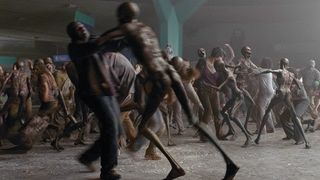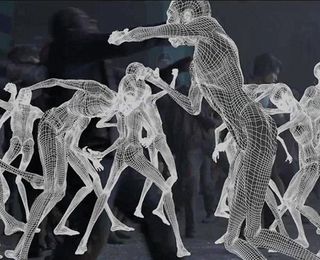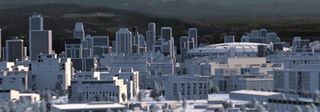How Look Effects breathed life into the zombie genre
With a bit of romance and a lot of CG, Warm Bodies is a zombie movie with a fresh twist. Mark Ramshaw find out how it was done.
For a breed of monster with no communication skills and little motivation other than to chase down their next meal, zombies have proven extraordinarily versatile as a metaphor for society's various ills. In the case of Jonathan Levin's witty Warm Bodies, that target is the loneliness of our modern society: R, the film's romantic lead, just wants to make a connection - but that's not so easy when your heart has stopped beating and you hunger for brains.
While the fleshy undead in the film are relatable, the more extreme form of undead - the 'Boneys' - are stripped down killing machines. Responsibility for creating these and various ruined city enhancements fell to Look Effects. "We knew going in that we'd have to deal with a lot of character animation, along with matte paintings for the post-apocalyptic world, but first we needed to establish an office in Vancouver as the work needed to be handled in Canada, so the first task was to start everything up there," says digital effects supervisor Mat Krentz.
The Boneys
Krentz says that director Jonathan Levine clearly enjoyed this opportunity to really explore the visual effects process. "We had a great pipeline and workflow set up, so that he would make comments on grey-shaded Boneys for blocking and animation purposes."

Concept artist Peter Konig provided the initial creature design, from which renowned make-up effects artist Adrien Morot built a maquette that would later also prove useful for onset lighting reference. "At the same time, our lead character/art designer Jelmer Boskma created the model in ZBrush, and once that was approved we began texturing and adding detail," says Krentz. "Jonathan specifically didn't want to have any recognisable clothing on the Boneys, so we came up with the idea and look of the clothes starting to merge with the organic matter of what was left of their bodies."
Mocap versus keyframing
The original intention was to utilise motion capture as much as possible. "It's easy to assume that motion capture will just work, but when things get moved around and changed, you then end up having to go and re-do the mocap multiple times, or else just spend the time keyframing instead," says CG supervisor Dmitry Vinnik.
"When animation notes were pouring in for every Boney in every shot on a daily basis, there was no way to effectively motion-capture, and we ultimately came to the conclusion that keyframing was the more efficient way of handling it."

The biggest challenge then proved to be giving the Boneys an appropriate sense of menace, despite their rather fragile appearance. "To compensate we had the animators add more weight in the movements," says Krentz. "Our biggest breakthrough with reference for the animators was telling them to look at the movement of the T-1000 in the second Terminator movie."
However, the director's desire for a creature with a dried-up, almost skeletal appearance did make the relationship between the Boneys' underlying structure and overlaid skin remains easier to manage. "Deformation or simulation of skin is easier to handle on the skinnier meshes than on meshes with larger volumes," explains Vinnik. "We did, however, create a wide range of blend-shaped poses for extra control in situations where the skin sliding would be apparent - something that was easier than running a full sim."
Flying through the city
Beyond the swarms of ravenous Boneys, Look's workload also involved ensuring that the live plates - shot in Montreal - were given a suitably post-apocalyptic makeover. This involved several hero shots in addition to extensive matte painting work, including a fluid, accelerated camera sweep through the city. The trick, says Vinnik, was to split it down into three separate parts.
In the first part of the fly through the camera pans across the airport grounds, past a building covered in digitally added shattered glass panes. "In the second part, we had a digital forest in addition to the cityscape. In the third part the shot goes over a zombie wall, where we had to hook up with the plate again. Here we modelled and extended the city in the background and used that to create a matte to seamlessly blend with the live plate. It was the most difficult shot of the entire production."

In contrast to other zombie-infested Hollywood movies, Warm Bodies is a film that wears its visual effects enhancements lightly. But it's the way that Look's work is used in service of the story rather than as obvious eye candy that ultimately makes both the CG and the film itself so satisfying.
"This film was especially pivotal for Look," admits Krentz. "We hadn't really done any character animation work before, so this was a new experience for us. We're very proud of the work, and to have helped Jonathan tell such an unusual story."
Words: Mark Ramshaw
This article originally appeared in 3D World issue 173.
Liked this? Read these!
- The best 3D movies of 2013
- Discover what's next for Augmented Reality
- Brilliant free 3D models to help in your projects
Zombies, eh? What are they like? Tell us in the comments!

Thank you for reading 5 articles this month* Join now for unlimited access
Enjoy your first month for just £1 / $1 / €1
*Read 5 free articles per month without a subscription

Join now for unlimited access
Try first month for just £1 / $1 / €1
Get the Creative Bloq Newsletter
Daily design news, reviews, how-tos and more, as picked by the editors.
The Creative Bloq team is made up of a group of design fans, and has changed and evolved since Creative Bloq began back in 2012. The current website team consists of eight full-time members of staff: Editor Georgia Coggan, Deputy Editor Rosie Hilder, Ecommerce Editor Beren Neale, Senior News Editor Daniel Piper, Editor, Digital Art and 3D Ian Dean, Tech Reviews Editor Erlingur Einarsson and Ecommerce Writer Beth Nicholls and Staff Writer Natalie Fear, as well as a roster of freelancers from around the world. The 3D World and ImagineFX magazine teams also pitch in, ensuring that content from 3D World and ImagineFX is represented on Creative Bloq.
